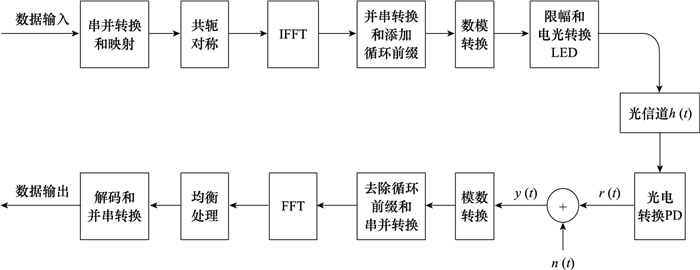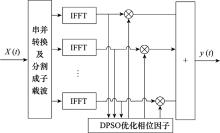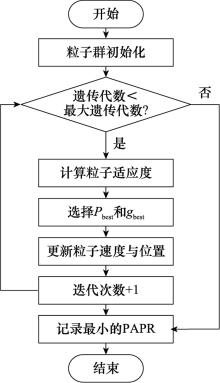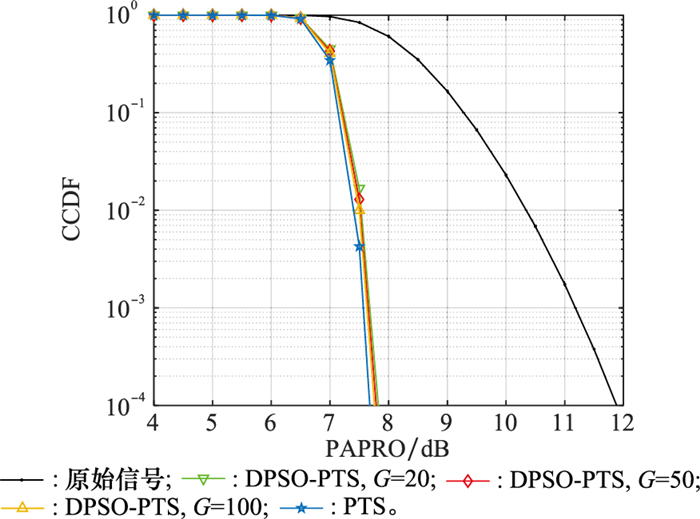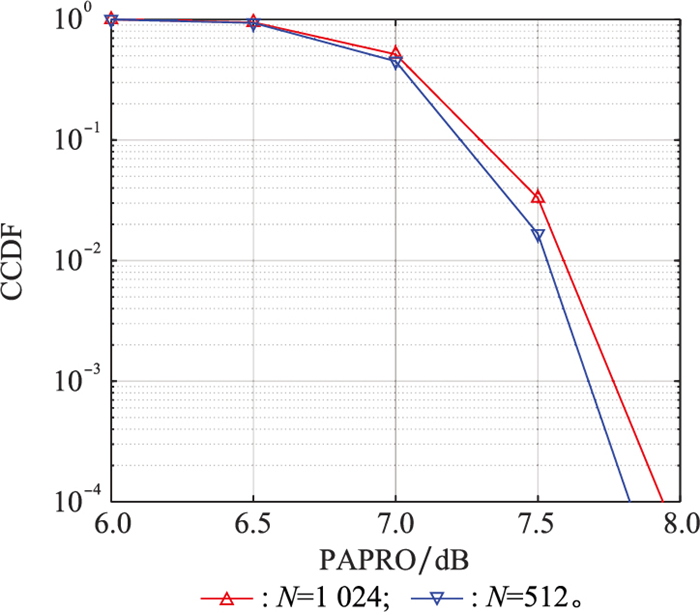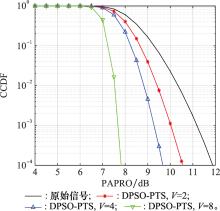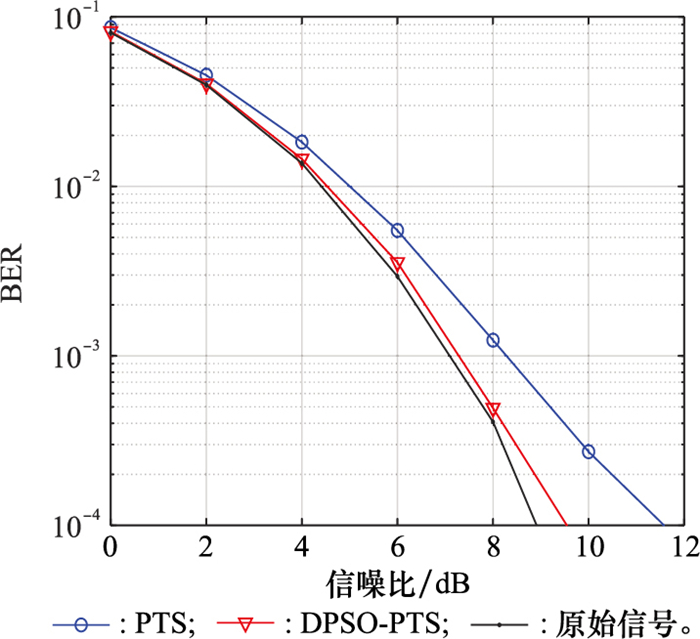| 1 |
VAPPANGI S , VAKAMULLA V M . A low PAPR multicarrier and multiple access schemes for VLC[J]. Optics Communications, 2018, 425 (4): 121- 132.
|
| 2 |
ABDULKAFI A A, ALIAS M Y, HUSSEIN Y S. Performance analysis of DCO-OFDM in VLC system[C]//Proc. of the IEEE Malaysia International Conference on Communications, 2016: 163-168.
|
| 3 |
ANTONIO C , VALERIA L , MAURO B . Adaptive modulation control for visible light communication systems[J]. Lightwave Technology, 2021, 39, 2780- 2789.
doi: 10.1109/JLT.2021.3056177
|
| 4 |
ZHANG Y T , ZHAO L , ZHANG F . Performance optimization of visible light OFDM communication system based on wavelet transform[J]. Laser Technology, 2020, 44 (2): 261- 265.
|
| 5 |
ZHANG J , ZHANG J . Research on partial linear companding transform for reducing the clipping distortion of visible light OFDM system[J]. Journal of Signal Processing, 2016, 32 (1): 113- 118.
|
| 6 |
MIRIYALA G , MANI V V . A new PAPR reduction technique in DCO-OFDM for visible light communication systems[J]. Optics Communications, 2020, 474, 126064.
doi: 10.1016/j.optcom.2020.126064
|
| 7 |
YU Z H , BAXLEY R J , ZHOU G T . EVM and achievable data rate analysis of clipped OFDM signals in visible light communication[J]. Eurasip Journal on Wireless Communications & Networking, 2012, 2012, 321.
|
| 8 |
TONG Z R , HUY N , ZHANG W H . PAPR reduction in CO-OFDM systems using IPTS and modified clipping and filtering[J]. Optoelectronics Letters, 2018, 14 (3): 209- 211.
doi: 10.1007/s11801-018-7210-2
|
| 9 |
AHMAD R , SRIVASTAVA A . PAPR reduction of OFDM signal through DFT precoding and GMSK pulse shaping in indoor VLC[J]. IEEE Access, 2020, 8, 122092- 122103.
doi: 10.1109/ACCESS.2020.3006247
|
| 10 |
赵瑶, 王翀, 杨宏, 等. 改进的可见光通信系统SLM峰均比抑制方法[J]. 系统工程与电子技术, 2019, 41 (4): 916- 920.
doi: 10.3969/j.issn.1001-506X.2019.04.30
|
|
ZHAO Y , WANG C , YANG H , et al. Improved SLM peak-to-average ratio suppression method for visible light communication system[J]. Systems Engineering and Electronics, 2019, 41 (4): 916- 920.
doi: 10.3969/j.issn.1001-506X.2019.04.30
|
| 11 |
HU W W . PAPR Reduction in DCO-OFDM visible light communication systems using optimized odd and even sequences combination[J]. IEEE Photonics Journal, 2019, 11 (1): 2632- 2648.
|
| 12 |
RIFAT K , MUHAMMED Y Y , MURAT U , et al. A 130 nm CMOS receiver for visible light communication[J]. Lightwave Technology, 2022, 40, 3681- 3687.
doi: 10.1109/JLT.2022.3150250
|
| 13 |
MERAH H , MESRI M , TALBI L . Complexity reduction of PTS technique to reduce PAPR of OFDM signal used in wireless communication system[J]. IET Communication, 2019, 13 (7): 939- 946.
doi: 10.1049/iet-com.2018.5705
|
| 14 |
徐东明, 杨杰. 基于改进的粒子群算法抑制OFDM的峰均比[J]. 西安邮电大学学报, 2017, 22 (4): 10- 14.
|
|
XU D M , YANG J . Peak-to-average ratio suppression of OFDM based on improved particle swarm optimization[J]. Journal of Xi’an University of Posts and Telecommunications, 2017, 22 (4): 10- 14.
|
| 15 |
张帅, 杨霖, 李少谦. PSO与相位因子优选对结合降低OFDM峰均比的算法[J]. 系统工程与电子技术, 2012, 34 (7): 1479- 1483.
doi: 10.3969/j.issn.1001-506X.2012.07.32
|
|
ZHANG S , YANG L , LI S Q . An algorithm to reduce the peak-to-average ratio of OFDM by combining PSO and phase factor optimization[J]. Systems Engineering and Electronics, 2012, 34 (7): 1479- 1483.
doi: 10.3969/j.issn.1001-506X.2012.07.32
|
| 16 |
PRASAD S , JAYABALAN R . PAPR reduction in OFDM using scaled particle swarm optimisation based partial transmit sequence technique[J]. The Journal of Engineering, 2019, 22 (5): 3460- 3468.
|
| 17 |
KENNEDY J, EBERHART RC. A discrete binary version of the particle swarm algorithm[C]//Proc. of the IEEE International Conference on Systems, Man, and Cybernetics. Computational Cybernetics and Simulation, 1997: 4104-4108.
|
| 18 |
LIANG H, CHEN Y R, HUANG Y F, et al. A modified genetic algorithm PTS technique for PAPR reduction in OFDM systems[C]//Proc. of the 15th Asia-Pacific Conference on Communications, 2009: 170-173.
|
| 19 |
杨霖, 张帅, 王小波. 改进的GA-PTS降低OFDM峰均比[J]. 电子科技大学学报, 2013, 42 (3): 338- 343.
doi: 10.3969/j.issn.1001-0548.2013.03.004
|
|
YANG L , ZHANG S , WANG X B . Improved GA-PTS reduces the peak-to-average ratio of OFDM[J]. Journal of University of Electronic Science and Technology, 2013, 42 (3): 338- 343.
doi: 10.3969/j.issn.1001-0548.2013.03.004
|
| 20 |
LI L , XUE L S , CHEN X H , et al. Partial transmit sequence based on discrete particle swarm optimization with threshold about PAPR reduction in FBMC/OQAM system[J]. IET Commun, 2022, 16 (12): 142- 150.
|
| 21 |
王沁, 李磊, 陆成勇. 基于动态离散粒子群优化的PTS相位系数搜索算法[J]. 系统仿真学报, 2010, 22 (12): 2799- 2804.
|
|
WANG Q , LI L , LU C Y . PTS phase coefficient search algorithm based on dynamic discrete particle swarm optimization[J]. Journal of System Simulation, 2010, 22 (12): 2799- 2804.
|
| 22 |
彭小峰, 曹阳, 杨家旺, 等. 室内可见光通信系统中的OFDM与ACO-OFDM调制技术研究[J]. 光通信技术, 2016, 40 (7): 60- 62.
|
|
PENG X F , CAO Y , YANG J W , et al. Research on modulation technology of OFDM and ACO-OFDM in indoor visible light communication system[J]. Optical Communication Technology, 2016, 40 (7): 60- 62.
|
| 23 |
ASADZADEH K, DABBO A, HRANILOVIC S. Receiver design for asymmetrically clipped optical OFDM[C]//Proc. of the GLOBECOM Workshops, 2011: 777-781.
|

